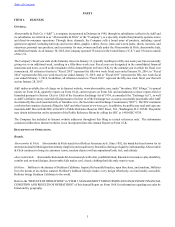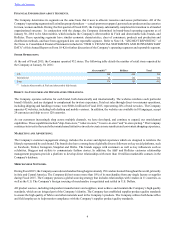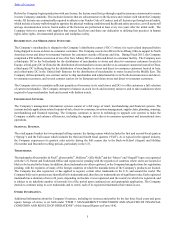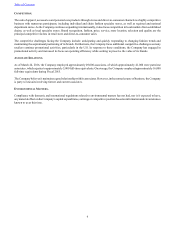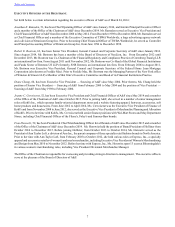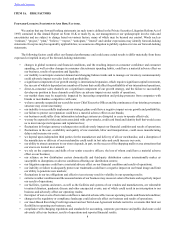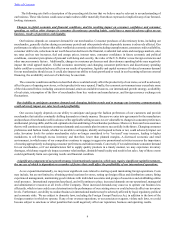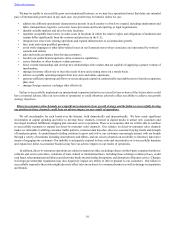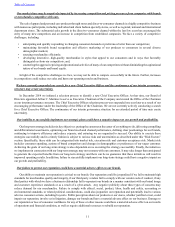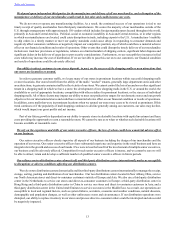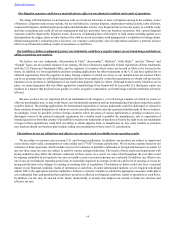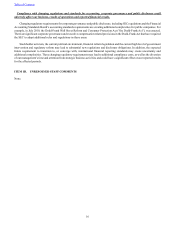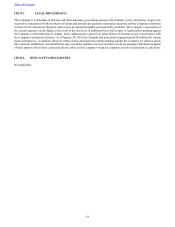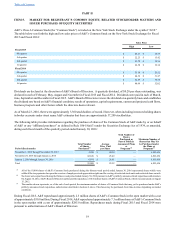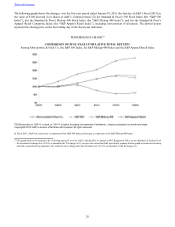Abercrombie & Fitch 2015 Annual Report Download - page 13
Download and view the complete annual report
Please find page 13 of the 2015 Abercrombie & Fitch annual report below. You can navigate through the pages in the report by either clicking on the pages listed below, or by using the keyword search tool below to find specific information within the annual report.
Table of Contents
13
We depend upon independent third parties for the manufacture and delivery of all our merchandise, and a disruption of the
manufacture or delivery of our merchandise could result in lost sales and could increase our costs.
We do not own or operate any manufacturing facilities. As a result, the continued success of our operations is tied to our
timely receipt of quality merchandise from third-party manufacturers. We source the majority of our merchandise outside of the
U.S. through arrangements with approximately 150 vendors which includes foreign manufacturers located throughout the world,
primarily in Asia and Central America. Political, social or economic instability in Asia and Central America, or in other regions
in which our manufacturers are located, could cause disruptions in trade, including exports to the U.S. A manufacturer’s inability
to ship orders in a timely manner or meet our quality standards could cause delays in responding to consumer demands and
negatively affect consumer confidence or negatively impact our competitive position, any of which could have a material adverse
effect on our financial condition and results of operations. Other events that could disrupt the timely delivery of our merchandise
include new trade law provisions or regulations, reliance on a limited number of shipping carriers, significant labor disputes and
significant delays in the delivery of cargo due to port security considerations. Furthermore, we are susceptible to increases in fuel
costs which may increase the cost of distribution. If we are not able to pass this cost on to our customers, our financial condition
and results of operations could be adversely affected.
Our ability to attract customers to our stores depends, in part, on the success of the shopping malls or area attractions that
our stores are located in or around.
In order to generate customer traffic, we locate many of our stores in prominent locations within successful shopping malls
or street locations. Our stores benefit from the ability of the malls’ “anchor” tenants, generally large department stores and other
area attractions, to generate consumer traffic in the vicinity of our stores. We cannot control the loss of an anchor or other significant
tenant in a shopping mall in which we have a store; the development of new shopping malls in the U.S. or around the world; the
availability or cost of appropriate locations; competition with other retailers for prominent locations; or the success of individual
shopping malls. All of these factors may impact our ability to meet our productivity targets for our domestic stores and our growth
objectives for our international stores and could have a material adverse effect on our financial condition or results of operations.
In addition, some malls that were in prominent locations when we opened our stores may cease to be viewed as prominent. If this
trend continues or if the popularity of mall shopping continues to decline generally among our customers, our sales may decline,
which would impact our gross profits and net income.
Part of our future growth is dependent on our ability to operate stores in desirable locations with capital investment and lease
costs providing the opportunity to earn a reasonable return. We cannot be sure as to when or whether such desirable locations will
become available at reasonable costs.
We rely on the experience and skills of our senior executive officers, the loss of whom could have a material adverse effect
on our business.
Our senior executive officers closely supervise all aspects of our business including the design of our merchandise and the
operation of our stores. Our senior executive officers have substantial experience and expertise in the retail business and have an
integral role in the growth and success of our brands. If we were to lose the benefit of the involvement of multiple senior executives,
our business could be adversely affected. Competition for such senior executive officers is intense, and we cannot be sure we will
be able to attract, retain and develop a sufficient number of qualified senior executive officers in future periods.
Our reliance on two distribution centers domestically and third-party distribution centers internationally makes us susceptible
to disruptions or adverse conditions affecting our distribution centers.
We rely on two distribution centers domestically and four third-party distributions centers internationally to manage the receipt,
storage, sorting, packing and distribution of our merchandise. Our two distribution centers located in New Albany, Ohio, service
our North American stores and direct-to-consumer customers outside of Europe and Asia. We also use a third-party distribution
center in the Netherlands to service our stores and direct-to-consumer customers in Europe; a third-party distribution center in
Hong Kong and a third-party distribution center in China to service our stores and direct-to-consumer customers in Asia; and a
third-party distribution center in the United Arab Emirates to service our stores in the Middle East. As a result, our operations are
susceptible to local and regional factors, such as system failures, accidents, economic and weather conditions, natural disasters,
demographic and population changes, as well as other unforeseen events and circumstances. If our distribution operations were
disrupted, our ability to replace inventory in our stores and process direct-to-consumer orders could be interrupted and sales could
be negatively impacted.


